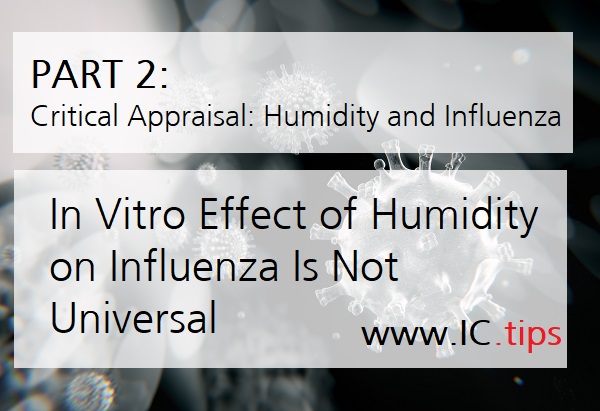Editor Note: This article is a Critical Review to our Call for Critical Appraisals: Humidity and Influenza https://infectioncontrol.tips/2018/06/11/call-critical-appraisals-humidity-influenza/ Please send your commentaries to [email protected]. Commentaries should cite peer-reviewed sources, and be a minimum of 250 words.
Critical Appraisal:
In Vitro Effect of Humidity on Influenza Is Not Universal
The paper titled “Influenza Virus Infectivity Is Retained in Aerosols and Droplets Independent of Relative Humidity” is marketed as a major article from the Infectious Disease Society of America (IDSA). The paper states “(o)ur data suggest, for the first time, that influenza viruses remain highly stable and infectious in aerosols across a wide range of relative humidities (sic). These results have significant implications for understanding the mechanisms of transmission of influenza and its seasonality.” The paper has been marketed in multiple websites touting the findings. Such examples include Science Daily (https://www.sciencedaily.com/releases/2018/06/180607082559.htm)
The title and conclusions of the paper should be considered specious. No other studies that I’ve found on this matter conclude that viral infection spread is not enhanced when there is less humidity. Briefly, the paper’s title and conclusion from the experimental design should be revised to state, ‘humidity levels have no material effect on the viability or perishability of viable influenza virus in indoor air.’ While this finding would still be significant, it does not conflict with the previously published results from studies and experiments that dry air promulgates virus better than moist.
Since all disease begins with the entry of a pathogen, the vector must be understood. For the flu virus, humans are the main vector. The flu virus is spread by human ingress and shedding of the virus, A virus is shed in several ways, but exhalation is the simplest to analyze, as a human emits 2500 gallons a day of air. When the sick patient (visitors, employees etc) exhales the virus laden droplets into air, the viability of the exhaled virus can vary by 100x fold, depending upon humidity levels between 15% and 50%. Exhaled virus behaves very differently depending upon humidity, but the reason for this is still elusive. These findings have been shown in countless studies, and anecdotally during the winter flu season, which has considerably lower humidity-holding content outdoors and hence the same amount of humidity indoors as measured in g/m3.
While the experiment and report seem to be well done and the findings valid and expected, the title and conclusions can propose an issue to public health in misleading practitioners and students. With such limited evidence, I suspect that lives could be lost in practicing this paper in infection control, hospital HVAC or even laboratory safety without additional vetting.












